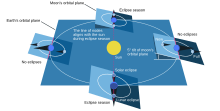This article has multiple issues. Please help improve it or discuss these issues on the talk page. (Learn how and when to remove these messages)
|


In astronomy, the new moon is the first lunar phase, when the Moon and Sun have the same ecliptic longitude.[2] At this phase, the lunar disk is not visible to the naked eye, except when it is silhouetted against the Sun during a solar eclipse.
The original meaning of the term 'new moon', which is still sometimes used in calendrical, non-astronomical contexts, is the first visible crescent of the Moon after conjunction with the Sun.[3] This thin waxing crescent is briefly and faintly visible as the Moon gets lower in the western sky after sunset. The precise time and even the date of the appearance of the new moon by this definition will be influenced by the geographical location of the observer. The first crescent marks the beginning of the month in the Islamic calendar[4] and in some lunisolar calendars such as the Hebrew calendar. In the Chinese calendar, the beginning of the month is marked by the last visible crescent of a waning Moon.
The astronomical new moon occurs by definition at the moment of conjunction in ecliptical longitude with the Sun when the Moon is invisible from the Earth. This moment is unique and does not depend on location, and in certain circumstances, it coincides with a solar eclipse.
A lunation, or synodic month, is the period from one new moon to the next. At the J2000.0 epoch, the average length of a lunation is 29.53059 days (or 29 days, 12 hours, 44 minutes, and 3 seconds).[5] However, the length of any one synodic month can vary from 29.26 to 29.80 days (12.96 hours) due to the perturbing effects of the Sun's gravity on the Moon's eccentric orbit.[6]
- ^ "New Moon". Flickr. NASA/GSFC. 15 June 2011.
- ^ Meeus 1991, p. 319.
- ^ "new moon". Oxford English Dictionary (Online ed.). Oxford University Press. (Subscription or participating institution membership required.)
- ^ Islamic Crescents' Observation Project, Visibility of Muharram Crescent 1432 AH Archived 10 May 2012 at the Wayback Machine; seen on 6 December in Algeria, Iran, Saudi Arabia, South Africa.
- ^ Seidelmann 1992, p. 576.
- ^ Espenak, Fred. "Eclipses and the Moon's Orbit". NASA Eclipse Web Site. NASA. Retrieved 11 December 2016.
Cite error: There are <ref group=lower-alpha> tags or {{efn}} templates on this page, but the references will not show without a {{reflist|group=lower-alpha}} template or {{notelist}} template (see the help page).